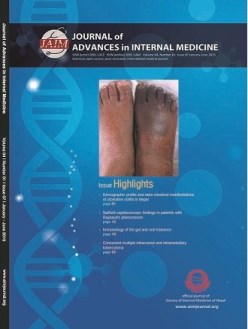Serial Ascitic Fluid Analysis – Prognostic Marker for Adverse Outcome in Spontaneous Bacterial Peritonitis in Liver Cirrhosis?
DOI:
https://doi.org/10.3126/jaim.v4i1.14174Keywords:
spontaneous bacterial peritonitis, ascites, prognosis, leukocytes, serial paracentesisAbstract
Background: Cirrhosis is a frequent cause of hospital admissions in Nepal with spontaneous bacterial peritonitis (SBP) being a major determinant of mortality. Limited diagnostic options preclude early risk stratification to improve patient outcomes. We assessed the predictive value of polymorphonuclear leukocyte counts (PMNs) and its association with mortality in hospitalized SBP patients.
Methods: We examined 51 cirrhotic patients diagnosed with SBP in a prospective case-control study admitted to a Nepali tertiary care facility from February 2010 to November 2012. Serial paracentesis and ascitic fluid analysis were performed at admission, 24, and 48 hours. Receiver operating characteristic (ROC) curves, repeated measures analysis of variance, and logistic regression evaluated ascitic PMNs as predictors of mortality.
Results: Deceased patients demonstrated significantly elevated mean circulating and ascitic PMNs. Ascitic PMNs in the non-survivors were significantly elevated upon admission and at 24 and 48 hours. These differences were significant based on absolute counts, relative differences and trends across time. ROC curves provided diagnostic thresholds (1600, 860, 500 cells/mm3) distinguishing the two groups upon presentation, at 24 and 48 hours respectively, with high sensitivities (100%), specificities (82.5-97.5%), and positive predictive values (52.4-84.6%). After adjusting for age and case severity, there was a 9.1-fold greater odds of mortality upon admission, for every increase of 500 ascitic PMNs.
Conclusion: In this study of cirrhotic patients with SBP, in-hospital mortality was associated with persistently elevated ascitic PMNs. Ascites PMN thresholds offer a quick, low-tech option to risk stratify patients, prognosticate mortality, and guide patient care in low resourced settings.
Journal of Advances in Internal Medicine 2015;04(01):6-12
Downloads
Downloads
Published
How to Cite
Issue
Section
License
This license enables reusers to distribute, remix, adapt, and build upon the material in any medium or format, so long as attribution is given to the creator.




